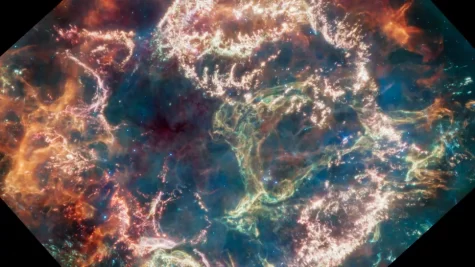Webb #2

Supernovas — the most terrifyingly beautiful explosions humanity has ever seen. They represent the end of a star’s life and the end of a seemingly endless internal conflict. During a star’s existence, the pressure created by nuclear fusion in its core continually fights the inward force of gravity, creating a stable stellar object. In this process, hydrogen fuses into helium, which fuses into carbon. If the star is massive enough, this fusion process will continue past carbon until it reaches iron. Now, iron, unlike the other elements, cannot fuse. Therefore, it builds up in the core until the balance between fusion pressure and gravity can no longer be maintained. The star implodes in mere seconds. The outer layers slam into the core, creating a powerful shockwave that blows out material into the beautiful shapes we see with our telescopes.
This spectacle is what the James Webb Space Telescope recently spotted in the image above. The stunning photo showcases the remnants of the Cassiopeia A supernova, whose light reached Earth 340 years ago from 11,000 light years away. However, this is no ordinary explosion. The Cassiopeia A supernova is the youngest we know of in the galaxy. This proposes several unique opportunities. Danny Milisavljevic, the principal investigator of these observations, explained that studying this explosion is almost like performing a “stellar autopsy to understand what type of star was there beforehand and how that star exploded.” This gives astronomers a window into the past, unlike anything they’ve had before.
In addition to these possibilities, astronomers are excited because of the level of detail the James Webb Space Telescope captured. The image was taken with Webb’s Mid-Infrared Instrument — a device that takes data outside the visible light spectrum. However, through some modification, the image can be transcribed to reveal what’s actually hidden out there.
The stunning photo displays red and orange filaments dispersed primarily around the perimeter. These colors represent star material colliding with the surrounding gas and dust. Additionally, perhaps the most notable aspect of the image is the wiry stretch of green in the middle of the explosion. Astronomers from this study have nicknamed this structure the “Green Monster” in honor of Fenway Park in Boston which displays the same name on its left field wall. As entrancing as it is, this part of the supernova also has scientists intrigued as its presence is unexpected, giving rise to more mystery around this spectacle. Alongside the red, orange, and green sections, the whispers of pink represent the dust and heavy elements created during the star’s life, such as neon, argon, and oxygen. This is particularly exciting as these elements are the building blocks for life. By examining them, we are essentially taking a look back at our history. As Milisavljevic put it, “By understanding the process of exploding stars, we’re reading our own origin story.” Who would’ve thought that by looking 11,000 light years away, we’re really studying what happened right here on our little blue rock when life decided to emerge? It seems that the James Webb Space Telescope has truly brought us full circle.
(he/him/his)
Roshan Mehta is a senior at Shaker High School, and this is his third year participating in the Bison. In the club, he serves as a writer...

